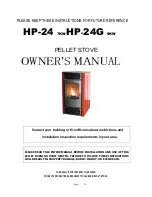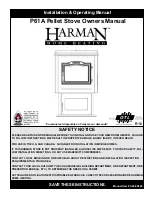
March 19, 2003 9
250-6422
Castile Pellet Stove
R
1. DO NOT INSTALL THE STOVE IN A SLEEPING ROOM.
2. THE STRUCTURAL INTEGRITY OF THE MOBILE HOME
FLOOR, WALLS AND CEILING/ROOF MUST BE MAIN-
TAINED (I.E., DO NOT CUT THROUGH FLOOR JOISTS,
WALL STUDS, CEILING TRUSSES, ETC.).
3. An outside air inlet must be provided for the combustion
air and be unrestricted while the stove is in use to prevent
room air starvation which causes smoke spillage. Smoke
spillage can also set off smoke alarms. Use Outside Air
Kit (Part 811-0872).
4. The combustion air duct system must be made of metal. It
must permit zero clearance to combustible construction and
prevent material from dropping into the inlet or into the area
beneath the dwelling and contain a rodent screen.
5. The stove must be secured to the mobile home by bolting it
to the floor (using lag bolts).
6. The stove must be grounded with #8 solid copper grounding
wire or equivalent, terminated at each end with an NEC
approved grounding device.
7. Refer to Clearances to Combustibles Section on page 4 for
listings to combustibles and appropriate chimney systems.
8. Seal all wall and floor inlets to prevent air or moisture
penetration. Check periodically to ensure the inlet is free of
obstruction (e.g., snow, ice).
9. Installation should be in accordance with the Manufactured
Home and Safety Standard (HUD), CFR 3280, Part 24.
THERMOSTAT INSTALLATION
1. A 24 volt AC thermostat is required to operate this pellet
stove and is included. It is equipped with an adjustable heat
anticipator. The current rating is .05 amps. The anticipator
needs to be adjusted to the lowest setting available.
MOBILE HOME INSTALLATION
2. When mounting a thermostat on a wall, be sure to follow your
thermostat installation instructions carefully.
NOTE: Be sure the thermostat is mounted level for
accurate readings. The thermostat should be mounted
on an inside wall and not in direct line with the stove
convection air.
NOTE: If the thermostat is located too close to the
stove, you may need to set the temperature setting
slightly higher to maintain the desired temperature in
your home.
3. There is a four screw terminal block located on the back of
the stove beside the power cord inlet. The center two screws
are for the thermostat wires.
1.
FUEL SIZE AND MATERIAL
Wood Pellets
Fuel pellets are made from sawdust or wood by-products.
If the source material is hardwood, they will have a higher
mineral content, creating a heavier ash. Minerals and other
noncombustible materials, such as sand, will turn into glass
when heated to the extreme temperatures our firepot reaches.
This is what forms clinkers in the bottom of the firepot. Trees
from different areas will vary in mineral content. That is why
some fuels produce more clinkers than others. Pellets are
manufactured in either 1/4” (6mm) or 5/16” (8mm) diameter
and many varying lengths. Pellet lengths may even vary
by lot from the same manufacturer which is why the feed
rate may need to be adjusted occasionally. Always burn dry
pellets. Burning pellets with high moisture content takes
heat from the pellets and tends to cool the stove, robbing
heat from your home.
We recommend that you buy fuel in multi-ton lots whenever
possible. Buying large quantities of fuel at once will greatly
reduce the number of times the feed adjustments will need
to be made. However, we do recommend trying various
brands before purchasing multi-ton lots to ensure customer
satisfaction.
Shelled Field Corn
Extensive factory and field testing has demonstrated shelled
field corn to be an efficient and very economical fuel. We
recommend the use of a 50-50 blend of corn and wood pellets.
The only change in operation is that the feed rate may require
a slight adjustment. The BTU output of the appliance varies
slightly compared to pellets, depending on the quality of the
corn used. In cases where it is acceptable for the stove to run
full time, 100% corn will work after the fire has been started
using wood pellets.
2. BEFORE YOUR FIRST FIRE
a. First, make sure your stove has been properly installed
and that all safety requirements have been met. Pay
particular attention to the fire protection, venting and
thermostat installation instructions.
b. Now open the front door of the stove and remove all of
the accessories that were placed there for shipment.
Remove any labels that may be affixed to the glass.
c. Check the position of the Thermocouple and make sure
that it protrudes approximately 1” (25mm) into the firepot.
It may be necessary to slide the Thermocouple and
Thermocouple Cover (ceramic protection tube) into their
proper positions. Now close the front door.
NOTE:
Thermocouple Cover tip must be touching the tip
of the Thermocouple.
OPERATING INSTRUCTIONS










































